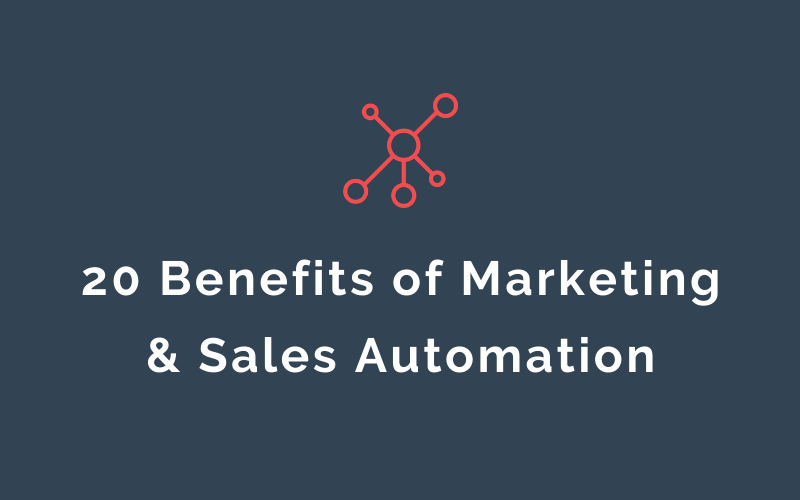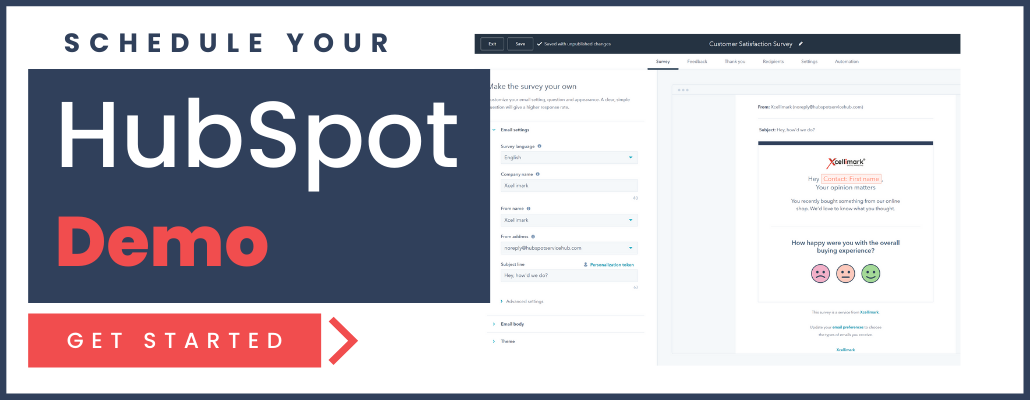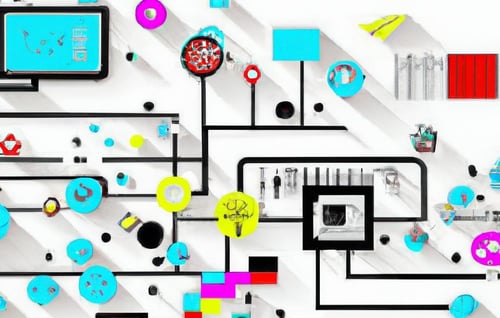20 Reasons Your Company Desperately Needs Marketing & Sales Automation


Marketing and sales automation is a technology platform that marketers and salespeople use to automate certain activities, tasks, and processes that previously required a significant amount of time and labor to perform manually.
These repetitive tasks typically include activities and tasks such as:
- Updating website content
- Email marketing
- Social media publishing
- Running ad campaigns
- Sales follow-up
- Personalized landing pages
- Adding calls-to-action (CTAs)
- Creating forms
- Creating promotional offers
- Marketing and sales lead follow-up
- Personalized emails
- Reporting
- Forecasting
- Scheduling meetings
- Data gathering
- Analytics
Marketing and sales automation helps you create and maintain information about your contacts, leads, and customers. Through a robust marketing, sales, and service automation platform such as HubSpot, you can know your contact’s personal interests, what activities they have performed across all your digital channels, and personal interactions with your content and employees.
Marketing and sales automation goes far beyond the normal silos of data that companies tend to get with the 10 – 40 different programs and software packages they use to help them with their marketing and sales processes.
A strong marketing automation platform integrated with a robust Customer Relationship Management (CRM) system will provide you with actionable intelligence that improves your overall marketing performance, sales results, and customer service.
But What About Our Jobs? Will We Lose Them to Automation?
It’s a big topic today even in political debates where there is this growing fear that automation is out to take away jobs. But that’s nothing new; there has been resistance to automation for centuries.
Automation was a key part of the Industrial Revolution that took off in England around 1750, allowing us to produce more with fewer people. However, throughout time, many people have resisted automation because it brings change.
I see similar fears with some CXOs, marketers, professional salespeople, and customer service managers today. Some people claim that “this is the way we have always done it” or “we’ll never get our colleagues to agree to learn a different way of doing things.”
Changing people’s behavior and the way they perform tasks can be difficult because many people don’t really want to change, no matter what the benefit.
Your Company May be at Risk
The transformation of company capabilities through automation happens in waves. It can be a disruptive process that includes confusion and frustration.
However, if you move too slowly, you risk having a considerable competitive disadvantage in the near future. Leaders today must harness the combined power of their workforce and automation to be able to adapt and shift to market demands.
Marketing and Sales Lead the Way in Automation
Today CMOs control as much budget for technology as CTOs/CIOs. Many times, they piece together different platforms and technologies trying to automate their processes. But automation silos are the wrong way to go about it.
The most effective marketing tool for a CMO or VP of Marketing and Sales is a Marketing and Sales Automation Platform. Some platforms, such as HubSpot, even offer integrated Customer Service Automation, a Website Content Management System (CMS), and a Sales CRM.
20 Benefits of Marketing & Sales Automation
- Saves Time
- Improves Your Ability to Generate More Leads
- Improves Your Ability to Qualify Leads
- Increases the Engagement of Your Leads with Your Company
- Increases Your Response Time to Your Leads
- Minimizes Mistakes Made by Marketing and Sales Personnel
- Improves the Accountability and Effectiveness of Marketing and Sales
- Increases the Efficiency of Marketing and Sales
- Improves Conversion Rates of Campaigns
- Improves Lifetime Value of Your Customers
- Creates Campaigns Faster
- Generates a More Accurate Forecast of Sales
- Improves Sales Capabilities
- Creates Better Marketing and Sales Team Collaboration
- Reduces Overall Costs
- Finds and Eliminates Bottlenecks in Your Operations and Processes
- Reduces Wasted Time and Effort in Managing Tech Tools
- Creates a Better Online Experience for Your Leads and Customers
- Improves Your Customer Service
- Improves your ROI

1. Saves Time
You can schedule activities and tasks in advance, freeing up your time to perform more important activities. If you are using an all-in-one platform such as HubSpot, you will save time moving from one technology silo platform to another to accomplish tasks and activities that can be done within the same software platform.
2. Improves Your Ability to Generate More Leads
You can use smart Calls-To-Action (CTAs) based on the information your prospect or customer has consumed on your website. You can also show different CTAs depending on the digital channel they utilize whether it’s search, social media, email, video, or other referring websites.
3. Improves Your Ability to Qualify Leads
You can qualify and nurture your leads by using automated workflows and personalized emails. Depending on the actions your leads take, different emails and internal notifications can be sent to help them continue through the sales funnel.
4. Increases the Engagement of Your Leads with Your Company
By segmenting your leads into automated lists, you can tailor your content and emails according to certain interests, needs, and demographic profiles. This helps to personalize your communications more, which in turns helps improve your overall engagement.
5. Increases Your Response Time to Your Leads
A marketing automation platform allows you to immediately respond to your leads based upon their requests and conversion activities. Automated emails can be sent, and internal notifications and tasks can be created so you can respond to your leads quickly while they are actively showing interest.
6. Minimizes Mistakes Made by Marketing and Sales Personnel
A good marketing automation platform keeps track of all correspondence and activities with your leads. You can then automate emails, the timing of responses, and even create tasks to keep from missing key steps in the marketing and sales process. Marketing and sales teams will also be able to know the stage of the buyer’s journey that a lead is in to help better determine the next best steps.
7. Improves the Accountability and Effectiveness of Marketing and Sales
Accountability is enhanced by having clearly defined processes, goals, and accurate reporting of the Deals and Opportunities that project revenue growth.
8. Increases the Efficiency of Marketing and Sales
Efficiency is improved by eliminating repetitive tasks and activities, which allows your staff to focus on more important tasks.
9. Improves Conversion Rates of Campaigns
You can A/B split test many different aspects of a marketing campaign including CTAs, landing pages, messaging, digital channels, workflows, marketing, and sales responses, which helps you to improve your conversion rates. Why guess when you can test?
10. Improves Lifetime Value of Your Customers
The intelligence gathered across marketing, sales, and customer service hubs helps to improve your approach and timing for upsells and cross-selling.
11. Creates Campaigns Faster
Through an easy-to-use interface, you can quickly build website pages, landing pages, forms, CTAs, email campaigns, and social media campaigns usually without the need for technical or design expertise.
12. Generates a More Accurate Forecast of Sales
With the ability to track leads, sales opportunities, proposals, deals, and sales within one system, you can create custom dashboards that help to forecast your sales opportunities with greater accuracy.
13. Improves Sales Capabilities
A robust CRM will allow you to record sales calls and provide coaching feedback to your sales team.
14. Creates Better Marketing and Sales Team Collaboration
By using one system that integrates all data and intelligence on marketing campaigns, leads, sales, and customer service, you can better align goals, strategies, communications, and customer insights, and provide unified reporting on what is and is not working.
15. Reduces Overall Costs
By combining many different silo technologies into one integrated system, you can usually lower your overall technology spend, reduce wasted time and effort running marketing campaigns, close more sales, and serve customers more efficiently and effectively.
16. Finds and Eliminates Bottlenecks in Your Operations and Processes
A marketing and sales automation platform provides greater insights into your current and future marketing, sales, and service processes, helping you to weed out inefficiencies and bottlenecks.
17. Reduces Wasted Time and Effort in Managing Tech Tools
By reducing the large volume of individual technology tools and combining them into a more integrated, robust system, your team will spend less time managing technology. They also receive more actionable intelligence and insights that will help improve marketing and sales performance.
18. Creates a Better Online Experience for Your Leads and Customers
You can deliver a personalized experience for each lead and customer that comes to your website, receives an email from you, or even books a meeting with you.
19. Improves Your Customer Service
You can automate and personalize routine messages for contract renewals, offer website visitors online chat, respond to help requests, educate your customers in your onboarding process, and create promotions and incentives according to activities that your leads or customers take.
20. Improves your ROI
You can improve your ROI in your overall marketing spend and sales efforts by automating tasks and processes, improving campaign results, focusing your sales efforts on the most qualified leads, and lowering your overall costs across staff, technology, and operations.
Marketing and Sales Automation is Key to Success
Marketing and sales automation is absolutely key in driving the kinds of business results and revenue your company needs to continue to be competitive in your marketplace and to grow revenue more cost effectively.








